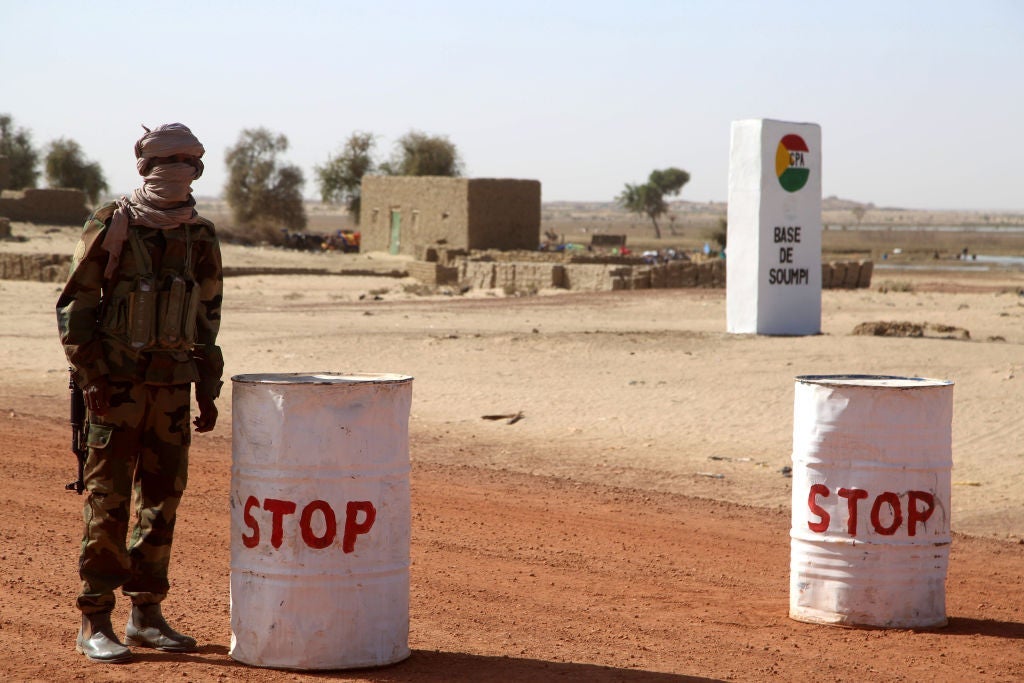

In January 2013, African heads of state called for a new blueprint for the African continent for the next 50 years, which became known as Agenda 2063. They ambitiously billed it as the masterplan for transforming Africa into a global economic powerhouse of the future. It was adopted by African governments in January 2015 and is currently being implemented by the African Union, the continental union that consists of 55 member states.
One of its seven lofty aspirations is “an integrated continent, politically united and based on the ideals of pan-Africanism and the vision of African renaissance”. Its 15 flagship projects include the formulation of a strategy for transforming the African economy from a supplier of raw materials to one that actively uses its own resources, the establishment of the African Continental Free Trade Area (AfCFTA), and the introduction of an ‘African Union passport’ and the removal of all visa requirements for its holders within Africa.
The initial stage of setting up AfCFTA has now been achieved (54 countries have signed the agreement out of 55 on the continent, the exception being Eritrea), creating the world’s biggest free market by number of participating countries (with a combined GDP of approximately $3.5trn). It started trading on 1 January 2021 and by March 36 countries had ratified it and undertaken the legal obligations for market opening and reducing barriers to trade.
African freedom of movement: a game changer
The free-trade pact could be an economic game changer but one of the biggest obstacles to its success are the myriad barriers to the freedom of movement on the continent. Since 2018, as part of its Agenda 2063 mission, the African Union has been promoting the Free Movement Protocol. However, by February this year, only 33 African countries had signed up to the protocol (including Kenya, Ghana, Angola and Tanzania) and only four countries had ratified it: Rwanda, Niger, Mali and São Tomé and Principe.
Freedom of movement is essential. Skills are missing in certain parts of Africa that exist in other parts of the continent. People must be able to move around. Paul Akiwumi, UNCTAD
Africa’s three biggest economies – Nigeria, Egypt and South Africa – which make up more than half the continent’s GDP – have not signed up to it, let alone ratified it.
How well do you really know your competitors?
Access the most comprehensive Company Profiles on the market, powered by GlobalData. Save hours of research. Gain competitive edge.

Thank you!
Your download email will arrive shortly
Not ready to buy yet? Download a free sample
We are confident about the unique quality of our Company Profiles. However, we want you to make the most beneficial decision for your business, so we offer a free sample that you can download by submitting the below form
By GlobalDataAfrican governments seem prepared to sign up to a trade deal but are reluctant to put into practice one of the vital elements – freedom of movement – so that the pact can work effectively. They have also been slow to put in place frameworks that recognise university degrees and technical qualifications from other African countries.
“This could be a transformative time for Africa,” says Paul Akiwumi, director, division for Africa, least developed countries and special programmes at the UN Conference on Trade and Development (UNCTAD). “There is a huge opportunity for the continent to escape from the yoke of the commodity-dependent model that exists today. AfCFTA provides a wonderful chance for African firms to leverage economies of scale and to trade across the region.
“However, for it to work properly, freedom of movement is essential. Skills are missing in certain parts of Africa that exist in other parts of the continent. People must be able to move around. African governments must have the political will to implement the Free Movement Protocol and to allocate financial resources to doing so.”
African migrants are escaping poverty
In the Western world, there exists an image of the African migrant as a poor refugee on a rickety boat trying to cross the Mediterranean or the English Channel. Of course, the reality is that most African migrants are trying to cross land borders on the continent itself, and in fact the number of migrants in the region is quite limited compared with other regions of the world (the number of internal migrants in Africa would have dropped in 2020, as well, as many countries closed their physical borders when the pandemic struck). These people are often escaping from impoverished circumstances in their home country and seeking economic opportunities for themselves and their families in wealthier African nations.
In 2019, the world had a total international migrant stock of 271 million people, up from 173 million in the year 2000, according to the UN. The total number of Africans who had migrated outside the continent reached 26.5 million at mid-year 2019, according to these figures. Studies have shown that more than half of all African migrants live in other African countries. According to the International Organisation for Migration, about 21 million African nationals were living in a neighbouring African country in 2019 (up from about 18.5 million in 2015) and the number of African nationals living in other regions within the continent was almost 19 million in the same year (up from 17 million in 2015).
According to the EU, in 2017, northern Africa (Libya and Egypt) had 1.6 million foreign-born residents, eastern Africa (Kenya, Ethiopia and Uganda) 6.9 million, western Africa (Côte d’Ivoire and Nigeria) 6.1 million, central Africa (Democratic Republic of the Congo, Cameroon and Angola) 3.1 million, and southern African (South Africa) had four million.
The average annual growth in the migrant stock was 3.1% in sub-Saharan Africa compared with 2.4% worldwide between 2000 and 2019, according to the UN. In 2019, international migrants made up only 2.2% of the African population compared with 21% in the Oceania region, 11% in Europe and 16% in North America.
In 2019, Africa hosted a total of 7.3 million refugees (including asylum seekers) or 25% of the global refugee population (28.7 million), according to the UN. More than half of all refugees in Africa were hosted by countries in eastern Africa (3.8 million), with smaller numbers of refugees residing in middle and northern Africa (1.4 million each), western Africa (383,000) and southern Africa (288,000).
In 2019, an estimated 47% of all international migrants in Africa were women, very similar to the global share of female migrants (48%). In that year, Africa was the youngest continent for international migrants with a median age of 27 years compared with 33.8 in Latin America and the Caribbean and 42.7 in Europe.
Growing intra-regional migration had resulted in noticeable population growth in a number of African countries, in particular Equatorial Guinea, Niger, Angola, Uganda and the Democratic Republic of Congo. Intra-African migration is concentrated in specific corridors, with South Africa, Côte d’Ivoire, Nigeria, Kenya and Ethiopia receiving most of the continent’s migrants. Two sub-Saharan migration systems stand out: a southern African one, centred on South Africa as receiving migrants from most of the sub-region and involving mostly labour-related migration, and a western African system, based on the economic and socio-cultural dynamism of the sub-region, with no single country acting as a magnet.
An African need for visa-free travel regimes
However, one of the biggest challenges for travellers in Africa is visas. Latin America has made considerable progress in discarding visas and people in the region can travel freely without requiring them. However, the same cannot be said for Africa. It can be hard for Africans from one country to holiday or to go on a business trip to another African nation. It is often easier to travel around Africa on a EU passport than an African one.
One of the priorities for AfCFTA must be to work quickly on making freedom of movement within the continent smoother. Dimieari Von Kemedi, Alluvial Agriculture
The African Development Bank’s 2018 Africa Visa Openness Index Report catalogues the progress made by African nations to liberalise access to their country. The number of countries offering e-visas for Africans jumped from from nine in 2016 to 13 in 2017 and 16 in 2018. In the top 20 most African-friendly countries, the predominant regions are eastern Africa (eight countries), western Africa (seven countries) and southern Africa (four countries), while there is only one country in northern Africa (Mauritania) and no country in central Africa. Overall, Africans do not need a visa to travel to 25% of other African countries, they can get visas on arrival in 24% of other African countries, and they need visas to travel to 51% of other African countries.
"I would not say Africa has a problem with mobility, it is more that it can be a very slow process," says Dimieari Von Kemedi, chief executive officer at Alluvial Agriculture, a Nigerian-based company that helps smallholder farmers. "A businessperson should be able to travel easily from Nigeria to Kenya or South Africa, say, but it is not that simple. In the case of Kenya and Nigeria, their nationals must have a host to enter the other country, who must submit his or her own passport details as well. It is quite a bureaucratic procedure. It is pretty easy for South Africans to enter Nigeria but, sadly, that is not reciprocated. It has become quite hard for Nigerians to obtain a visa for that country.
"Nigeria itself is a very open country. People can move here very easily, including those from outside Africa. That's why people from all over Africa and the world live in Lagos. One of the priorities for AfCFTA must be to work quickly on making freedom of movement within the continent smoother. This is important if we are going to integrate the region economically and it is quite an easy step, really. It is not like constructing physical infrastructure between borders; it is just a question of getting the right visa and immigration systems in place."
Africa has a total of eight regional economic communities (RECs):
- The Arab Maghreb Union (UMA)
- The Common Market for Eastern and Southern Africa (Comesa)
- The Community of Sahel-Saharan States (CEN–SAD)
- The East African Community (EAC)
- The Economic Community of Central African States (ECCAS)
- The Economic Community of West African States (Ecowas)
- The Intergovernmental Authority on Development (IGAD)
- The Southern African Development Community (SADC)
There is a series of sub-regional initiatives trying to make it simpler for Africans to trade and move within each grouping. All the RECs have put in place regional trade arrangements but the stage and implementation of these arrangements differs a lot. In terms of the freedom of movement, major progress has been achieved in some regions, in particular in Ecowas, the EAC and the UMA. For example, the EAC passport is operational and allows multiple entries to citizens from partner states to travel freely within the EAC region for a period of six months.
International migration is easiest in western Africa
In Ecowas, there is visa-free movement for community nationals and international migration is more prevalent in western Africa than in any other region on the continent. In the Comesa region, visas are treated with flexibility for residents of the sub-region, and in the SADC region, citizens can obtain a visa for a maximum period of 90 days per year. However, establishment and residency require further procedures. In the central Africa region, progress has been slow, while in the IGAD region, countries apply reciprocity rules on visas. In UMA, as with IGAD, some form of reciprocity is applied on visas, except in the case of Tunisia, which allows citizens of other member states to access its territory freely.
Immigration is vital to build up the South African economy but the vibe is just not there at the moment. Jon Foster-Pedley, Henley Business School South Africa
"Within the Ecowas REC it is very easy for people to move around," says Victoria Billing, British ambassador to Senegal. "Dakar, the Senegalese capital, has a large expat population made up of people from other western African countries, including Guinea, Cabo Verde and Nigeria. Many came to study at universities in Dakar and decided to stay on. Within francophone western Africa, there is a lot of freedom of movement as well. However, it is true that there exist far fewer links between western and eastern Africa; culturally they are quite different places."
One of the biggest problems faced by African political leaders wanting to advance freedom of movement is xenophobia. This goes very much against the spirit of pan-Africanism that inspired many of the original independence movements but nonetheless exists, and it does call into question whether the African Union's dream of an 'AU passport' will ever be fulfilled.
In September 2019, the South African government was forced to apologise to Nigeria over a spate of xenophobic attacks against foreign workers in the country. No Nigerians were killed during the violence but Nigerian-owned shops and businesses are believed to have been targeted by the mobs (two Zimbabweans were killed). Tensions between the two countries were inflamed after videos and images were shared on social media purporting to show Nigerians being attacked and killed.
"We are very concerned and of course as a nation we [are] ashamed because this goes against the ethos of what South Africa stands for," Cyril Ramaphosa, South Africa's president, told the BBC at the time.
At the same time, about 75 Malawians living in South Africa were forced to flee their workplaces or homes during the attacks. They had to return home and many said they would never go back to South Africa. The World Bank says more than half of Malawi's population lives below the poverty line, and about one-quarter of them survive on less than $2 a day. For many, migrating to South Africa as a domestic labourer is their only option to escape poverty and many are working in the country illegally. However, poorer South Africans see the Malawians as a source of competition for jobs and homes.
"It is very hard for foreign people to get work permits in South Africa at the moment," says Jon Foster-Pedley, dean of the Henley Business School South Africa. "The country has very high unemployment, in particular among the young. These people really do not want foreigners coming in. Trade unions also favour a more 'closed door' policy. Covid-19 has only made matters worse. Of course, immigration is vital to build up the South African economy, but the vibe is just not there at the moment."
Why Rwanda is an east African oasis
Rwanda is one country where this 'vibe' does exist (or at least it did before the pandemic hit) and is seen by many as the oasis of the east African region, in particular from an economic migrant's point of view (of course, the country's human rights record is another matter). It launched its economic development agenda about 25 years ago under the tagline 'Rwanda is open for business' and has created an environment that encourages immigration and promotes immigrants to be integrated into the community.
Permits are formally given to immigrants according to the Immigration Law of 2006. The law does not grant preferential treatment to foreigners or nationals and treats them equally. Rwanda has formulated a National Migration Policy and Strategies Framework, which helps in managing immigrants, emigrants, trafficking in persons and migrant smuggling. It provides temporary residences and investment opportunities.
In particular, the country has attracted an influx of highly qualified Kenyans, who now dominate employment as accountants, university and technical college lecturers and teachers. Citizens of other neighbouring states have also taken up roles in semi‐skilled jobs, including working in motor garages, restaurants and beauty salons.
"Rwanda really stands out in the east African sub-region," says UNCTAD's Akiwumi. "It really has become an IT hub for the whole of the area and attracts very skilled people in that industry from the rest of east Africa. It also helps the African countries that these people come from; there is a transfer of technological know-how back to the home countries."
The massive issue of unaccompanied African migrant children demonstrates the importance of the continent's Free Movement Protocol. A lot of migration within Africa is taking place on an irregular basis and in an undocumented way. According to Unicef, 13.5 million children in Africa are displaced by poverty, conflict and climate change. These children – with or without their families – are likely to consider migrating to another country in search of some sort of livelihood.
The southern route of child migrants connects east Africa and the Horn of Africa with South Africa, via Tanzania, Malawi and Mozambique by sea and land. This route is dominated by mostly Ethiopian and Somali migrants.
However, child migrants are at risk of being mugged, arrested, raped, kidnapped or killed. On arrival in their destination country, many are at risk of becoming sex workers. Unicef says that while a robust framework for dealing with unaccompanied migrant children exists on the continent, a lot more must be done to bridge the gap between commitments and implementation across the continent. Key priorities should focus on supporting governments to adopt an all-inclusive approach to child protection, irrespective of nationality and status, and the harmonisation of data across the continent.
Africa stands at an economic crossroads. AfCFTA has the potential to transform the continent and to lift millions of people out of poverty. However, for it to work properly, African governments must find the political will to educate their people about the benefits of international migration and about how migrants can enrich their countries. They can start this process by making visa-free travel a lot easier. It is only then that the pan-African ideal lying behind the vision of the region's independence movement leaders can start to be fulfilled.







